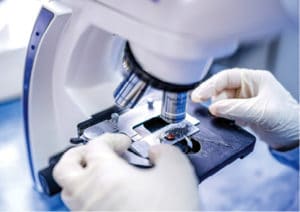

Managing Director,
iGenetic Diagnostics
Mobile platforms hold the capacity of revolutionising the diagnostics industry, creating opportunities for telemedicine. The future of diagnostics could comprise smartphones, tablets and laptops at health clinics, says Arunima Patel, Managing Director, iGenetic Diagnostics, for Elets News Network (ENN).
Healthcare industry in India is currently at a place from where it can grow exponentially, given the right resources. The recent spike in the pace and speed of growth of healthcare can be attributed to strengthening coverage, improved quality of services, and increase in expenditure by public as well as private players.

Amid this impressive progress, one industry that has emerged as a prominent game changer in the healthcare sector is diagnostics. In a market where there are no certain governing laws to check quality of services, the private players have taken upon themselves to introduce standardisation in their practice and follow protocols set by international medical bodies to ensure consistent and world-class service to all their consumers.
The availability of good diagnostics is central to both the treatment and control of infectious diseases. Since parasitic and vector- borne diseases have the highest burden in low-income developing countries like India, the design of diagnostics for such diseases is complicated.
In such a setting, the ideal diagnostics facility must have certain innovative characteristics. Innovation in diagnostics can bring significant patient and economic benefit. Technologies that are faster, cheaper, more accurate, more portable, user- friendly and easily connected with healthcare systems, have the potential to increase productivity and improve care pathways.

Design for India
There is so much talk around Make in India but our focus should be Design for India. Today, 90 per cent of development and innovations in diagnostics are done in western markets, which need to be bought and adapted for the Indian consumer. Every technology that we import is meant for the western population. The need of the hour is indigenous solutions created in India for problems faced by healthcare consumers in emerging markets. We need to Design for India in the country and actually manufacture anywhere. This is specially relevant in infection detection where bacteria, viruses and fungi are different as compared to western world.
User-friendly: Affordable and simple to perform
Affordable innovation that presents ways in which to pioneer, be versatile, and do a lot with less, will facilitate a resource-constrained country like India, address challenges in provision. Such a model will make sure that healthcare is available and accessible to each subject of the country on a priority basis. For this, the nations innovation capability must be increased through the correct implementation of business incentives, policy support, finance mechanisms, human capital and best-in-class infrastructure. The aim ought to be to form a righteous cycle of basic understanding, wherever knowledge is seamlessly translated into sensible solutions to deal with unmet health care needs.
Equipment-free
Mobile platforms hold the capacity of revolutionising the diagnostics industry, creating opportunities for telemedicine. The future of diagnostics could comprise smartphones, tablets and laptops at health clinics.
Connected non-invasive diagnostic devices can capture diagnostic and patient info and phones or tablets could connect securely via 3G/4G data to cloud- based apps. Cloud services could connect to a network of specialists using smartphones, ready to provide quick responses.
Eighty-five percent of skin issues can be fully diagnosed by a dermatologist with a photo taken by a smartphone. From the embarrassing STDs and acne to rashes that dont go away and other skin issues, there is a huge scope for consumer and the doctor in managing the interactions through a mobile platform.
Digital diagnostics

Taking help of the new smart mobile platform which can help in infiltrating the remotest regions of India. India has the cheapest mobile services on the planet. 3G is already available across much of India. There will continue to be a ferocious price war to capitalise on the 3G and 4G spectrum purchased by the mobile carriers. This is all good news for consumers and healthcare providers as the combo of omnipresent smartphones and 3G data creates a massive low-cost platform for delivering healthcare services“the foundation of telemedicine. This device will be integrated through 3G/4G with a group of quality specialists who can deliver opinions on patient diagnostics within minutes. Patients dont have to take time away from work for an appointment. There is also no travel time or associated expenses, such as paying for commute or child care.
Telemedicine
Telemedicine is referred to the innovation of remote delivery of diagnostic services, such as report assessments or consultations, over the telecommunications infrastructure. It permits medical personnel to judge, diagnose and treat patients while curbing the requirement for an in-person visit. Telemedicine permits diagnostic facilities to share patient info, laboratory results, with an expert at another location. Interactive telemedicine permits physicians and patients to speak in real time. Such sessions may be conducted within the patients home or in a nearby medical facility, using telephonic conversations or by video conferencing software system. Through telemedicine, patients in rural areas can avail speciality diagnostic services in hassle-free manner.
[su_quote]Telemedicine permits diagnostic facilities to share patient info, laboratory results, with an expert at another location. It helps patients in rural areas to avail speciality diagnostic services in hassle free manner.[/su_quote]
Technological advancements
Understanding the need of a new diagnostic technology in the medical framework paves-way for advancements in testing research and development of new tests that are more accurate, more reliable and more cost effective.
This may include replacing an existing test, as a triage test to direct the need for additional tests, or as an add-on test performed after the current diagnostic workup to further stratify patients.
Understanding the role of a new test highlights its impact on existing diagnostic test pathways, and resource utilization. It may identify places where disinvestment in existing diagnostics may be possible
Today, advanced technologies such as molecular diagnostics are made available at affordable prices to provide a far robust and accurate diagnosis in critical conditions such as infection, cancer, infertility and others.
Be a part of Elets Collaborative Initiatives. Join Us for Upcoming Events and explore business opportunities. Like us on Facebook , connect with us on LinkedIn and follow us on Twitter , Instagram.












